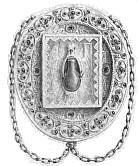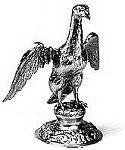|
Exodus 30:22-25 "And the Lord spoke to Moses, Saying: Take
spices, of principal and chosen myrrh five hundred sicles, and of
cinnamon half so much, that is, two hundred and fifty sicles, of
calamus in like manner two hundred and fifty. And of cassia five
hundred sicles by the weight of the sanctuary, of oil of olives the
measure hin: And thou shalt make the holy oil of unction, an ointment
compounded after the art of the perfumer..."
James 5:14 "Is any man sick among you? Let him bring in the priests of
the church, and let them pray over him, anointing him with oil in the
name of the Lord."
There
are three kinds of sacred oils, all of which signify the work of the
Holy Spirit and symbolize it in that oil "serves to sweeten, to
strengthen, to render supple" (Catholic Encyclopedia). The three holy
oils are:
- The
Oil of Catechumens ("Oleum Catechumenorum" or "Oleum Sanctum") used in Baptism along with water, in the consecration
of churches, in the blessing of Altars, in the
ordination of priests, and, sometimes, in the crowning of Catholic
kings and queens.
- The
Holy Chrism ("Sanctum Chrisma") or "Oil of Gladness," which is olive
oil mixed with a small amount of balm or balsam. It is used in Confirmation, Baptism, in the
consecration of a Bishop, the consecration of a various things such as
churches, chalices, patens, and bells.
- The
Oil of the Sick ("Oleum Infirmorum"), which is used in Unction
The
blessing of oils is performed by the Bishop of each diocese on Maundy Thursday ("Holy Thursday") in the
diocese's cathedral during a "Chrism Mass." The oils are kept in metal
or glass bottles called "chrismatories," "chrismals," or "ampullae."
These vessels are then stored in a cabinet called an "ambry,"
which is usually fixed to the wall of the sanctuary. Priests also have
a portable "oilstock" which has a section for each of the three holy
oils. Lay people are not to handle the holy oils, even to carry them,
except in emergencies.
Just for fun
Legends
surround the ampullae used to hold the holy oils used, in addition to
the oil of catechumens, in coronating the monarchs of England and
France. 
A French legend relates that the holy oil used in crowning the French
monarchs was brought down from Heaven by a dove bearing an ampulla at
the Baptism of Clovis, the warring Salic Frank, by Bishop Remigius
("Remi") at Reims on Christmas Day, A.D. 496. The conversion of Clovis
to Christianity was the beginning of France's status as "elder daughter
of the Church." The dove-borne vial, known in France as the "Sainte
Ampoule," is reserved at the cathedral of Reims to this day.
In England, the Blessed Virgin is said to have appeared to St. Thomas à
Becket and  given him an eagle-shaped ampulla filled with
holy oil, and a golden spoon to be used to crown England's Kings. The
ampulla was lost for two centuries, but was discovered before Henry
IV's coronation in 1399. When the oil it contained was used on the
Protestant Queen Elizabeth I in 1559, it is said to have gone rancid;
she is said to have remarked that "the grease smelt ill." England's
eagle-shaped ampulla is now reserved at
the Tower of London with the rest of the Crown Jewels. given him an eagle-shaped ampulla filled with
holy oil, and a golden spoon to be used to crown England's Kings. The
ampulla was lost for two centuries, but was discovered before Henry
IV's coronation in 1399. When the oil it contained was used on the
Protestant Queen Elizabeth I in 1559, it is said to have gone rancid;
she is said to have remarked that "the grease smelt ill." England's
eagle-shaped ampulla is now reserved at
the Tower of London with the rest of the Crown Jewels.
 Back to Being Catholic Back to Being Catholic
 Index Index
|
|

